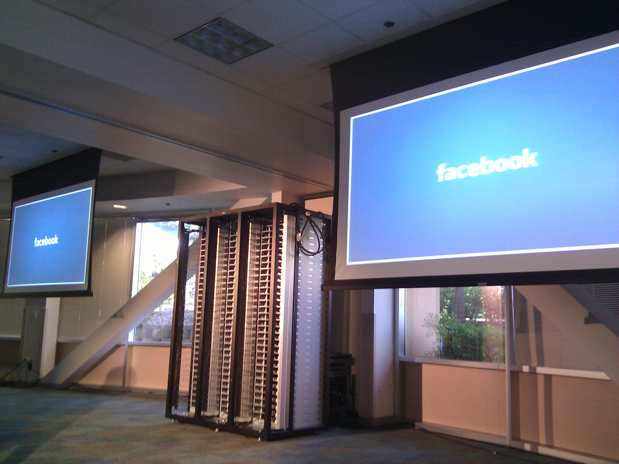
I’m sitting in Facebook headquarters in Palo Alto, where the company has invited dozens of press and members of the tech community — I’ve spotted nametags with ‘Apple’ and ‘Paypal’ on them, among many others — for a special event. Unlike many of Facebook’s past events, this one isn’t consumer-focused. Instead, it’s all about infrastructure.
The invitation to the event says that they’ll be giving us “a behind-the-scenes look at the latest technology powering Facebook”. And we’re hearing that it will include information on how Facebook is building out highly efficient data centers — and that it plans to open source its technology.
I’ll be live-blogging the event below.
Mark Zuckerberg has taken the stage. Today they’re going to be announcing the “The Open Compute Project”, which is at Opencompute.org.
Facebook has made many advances with server efficiency as it’s grown. Lots of custom technology. But there are plenty of other companies that could benefit from this. Facebook has been working on what it’s announcing today for over a year.
Facebook’s head of infrastructure has taken the stage.
He says that traditionally companies start off by leasing a data center. Over time, they expand to additional data centers. Some data center operators are flexible, but you have to work with landlord, and there are limitations, because a tenant will come in after you. So Facebook built its first data center in Prineville, Oregon. And then it innovated on both software and the servers and data centers themselves.
The Oregon data center is now operating at much higher efficiency than industry average and leased data centers, which is good for the environment — 38% more efficient in terms of energy usage and 24% cost savings. This new server technology was built by three people.
Because Facebook has benefitted from advancements made by other companies in the last ten years, they’re ‘giving back’ by sharing the specifications and design documents used to create this. And, as others improve on this design, Facebook will benefit too.
Typical data center power goes through transformers that lead to 11-17% loss of power before reaching the server. Facebook’s is using a configuration that loses 2%.
One way Facebook is conserving energy is by eliminating the need for a traditional air conditioning system. Facebook’s Oregon data center uses an advanced cooling system that doesn’t require air ducts. Instead it pulls in cool air from outside, which is then mixed with warmer air if it’s too cold, misted, passed through some holding areas and filtering systems, and is allowing to sink into the server room below — where it cools the servers without the need for air ducts.
The server chassis itself is spartan. Parts are easily accessible and can be quickly snapped into place. 94.5% efficient power supply accepting both AC and DC power. 22% fewer materials in the servers (less plastic, etc).
“It’s time to stop treating data centers like Fight Club and demystify what’s under the hood.” So Facebook is open sourcing all of the specs.
You can find more detailed specifications right here.